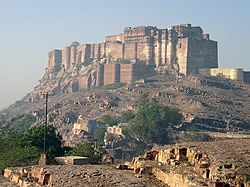Mehrangarh
| Mehrangarh Fort | |
|---|---|
| Jodhpur, Rajasthan, India | |

View of Mehrangarh Fort
|
|
| Coordinates | 26°17′52″N 73°01′06″E / 26.29784°N 73.01842°ECoordinates: 26°17′52″N 73°01′06″E / 26.29784°N 73.01842°E |
| Type | Fort |
| Site information | |
| Open to the public |
Yes |
Mehrangarh Fort (Hindi: मेहरानगढ़ का दुर्ग), located in Jodhpur, Rajasthan, is one of the largest forts in India. Built around 1460 by Rao Jodha, the fort is situated 410 feet (125 m) above the city and is enclosed by imposing thick walls. Inside its boundaries there are several palaces known for their intricate carvings and expansive courtyards. A winding road leads to and from the city below. The imprints of the impact of cannonballs fired by attacking armies of Jaipur can still be seen on the second gate. To the left of the fort is the chhatri of Kirat Singh Soda, a soldier who fell on the spot defending the Mehrangarh fort.
There are seven gates, which include Jayapol (meaning 'victory'), built by Maharaja Man Singh to commemorate his victories over Jaipur, Udaipur and Bikaner armies. Fattehpol (also meaning 'victory') gate was built by Maharaja Ajit Singh to mark the defeat of the Mughals. The palm imprints upon these still attract much attention.
The museum in the Mehrangarh fort is one of the most well-stocked museums in Rajasthan. In one section of the fort museum there is a selection of old royal palanquins, including the elaborate domed gilt Mahadol palanquin which was won in a battle from the Governor of Gujarat in 1730. The museum exhibits the heritage of the Rathores in arms, costumes, paintings and decorated period rooms.
Rao Jodha, the chief of the Rathore clan, is credited with the origin of Jodhpur in India. He founded Jodhpur in 1459 (Jodhpur was previously known as Marwar). He was one of Ranmal's 24 sons and became the fifteenth Rathore ruler. One year after his accession to the throne, Jodha decided to move his capital to the safer location of Jodhpur, as the one thousand years old Mandore fort was no longer considered to provide sufficient security.
With the trusted aid of Rao Nara (son of Rao Samra), the Mewar forces were subdued at Mandore. With that, Rao Jodha gave Rao Nara the title of Diwan. With the help of Rao Nara, the foundation of the fort was laid on 12 May 1459 by Jodha on a rocky hill 9 kilometres (5.6 mi) to the south of Mandore. This hill was known as Bhaurcheeria, the mountain of birds. According to legend to build the fort he had to displace the hill's sole human occupant, a hermit called Cheeria Nathji, the lord of birds. Upset at being forced to move Cheeria Nathji cursed Rao Jodha with "Jodha! May your citadel ever suffer a scarcity of water!". Rao Jodha managed to appease the hermit by building a house and a temple in the fort very near the cave the hermit had used for meditation, though only to the extent that even today the area is plagued by a drought every 3 to 4 years. Jodha then took an extreme measure to ensure that the new site proved propitious; he buried a man called "Raja Ram Meghwal" alive in the foundations. "Raja Ram Meghwal" was promised that in return his family would be looked after by the Rathores. To this day his descendants still live in Raj Bagh, "Raja Ram Meghwal's" Garden, an estate bequeathed them by Jodha.
...
Wikipedia

